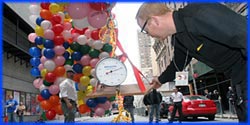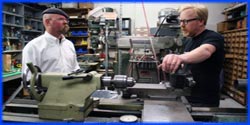


Premier Date: November 2, 2011
confirmed
For small-scale testing, Adam and Jamie built a miniature sewer pipe fitted with a full-length viewing window and three manholes. They pumped in enough methane to reach a 9% concentration in air (the center of its flammability range) and used a spark to set off the mixture. A test with both ends of the pipe open gave only a small flash of flame; when the ends were closed, all three covers flew off. The addition of metal debris to the pipe, simulating junk that might collect in a real sewer, launched the covers even higher due to a faster, larger flame front moving around all the obstructions.
They next built a 40 ft (12 m) sewer in a trench using concrete culvert sections, installed three manholes, and placed rolls of chain-link fencing in it to simulate debris. After burying it under 3 ft (91 cm) of dirt, they pumped in the methane and set it off. The resulting explosion threw the covers 150 ft (46 m) skyward and slightly shifted the dirt over the sewer. High-speed footage showed fire coming from only one manhole, indicating that a deflagration had taken place rather than a detonation. Judging the myth confirmed at this point, Adam and Jamie noted that a detonation might have sent the covers even higher.
busted
The team sprayed one half of a car with bedliner, leaving the other exposed, and carried out various crash tests. In 6 mph (10 km/h) front- and rear-end collisions with a concrete barricade, the treated side showed much less damage than the untreated one. However, when Tory rammed each side with a second car at 25 mph (40 km/h), the team found the same serious damage on both sides.
confirmed
Grant built a robot modeled after a German shepherd’s skull, calibrated to match its bite force. The team sprayed one sleeve on each of four jackets — denim, leather, canvas, quilted coat — and tested the robot on all eight sleeves. It easily bit through the untreated sleeves and damaged the dummy arms underneath, but could not penetrate the treated ones. Tory chose the quilted coat for testing against a police dog; after it had been completely sprayed, he put it on and suffered no injuries when the dog tried to bite him.
confirmed
The team built wood-frame and cinder block walls, one treated and one untreated of each type, and placed Buster behind each before setting off a C-4 charge 5 ft (1.5 m) in front. The untreated walls were badly damaged and threw large amounts of debris on Buster, while the treated ones showed no damage and protected him.